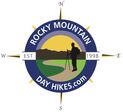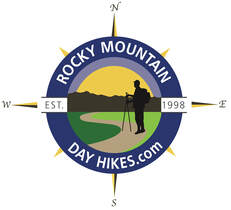|
Notes from the
Trail |
 Why is the return always longer when it’s not? This last week, after the snowbomb cyclone that hit the high plains with a vengeance, I tried out Wild Basin. I had not been there yet this winter and I found the road closed at the entrance gate; that would add some distance to the destination. The road was well covered with snow though, and the trail had not been packed down too much yet. I shoed around Copeland Lake and along the lower section of the road, going past the mid way gate that is the usual winter parking area. The walk to the Thunder Lake trailhead was an enjoyable travel, with a stop along the river in one of the few places that had open water. There were fluffy piles of snow perched on top of boulders and thin slices of ice where the boulders met the surface water. The open water maneuvered around the boulders and sounded a little like a summer mountain stream, pleasant. It was quite amazing to look around and see all the water that was about to melt and run down toward the Mississippi Delta and think of all of the flooding that it will do along the way over the next couple of months (there’s a report coming out of Chatham in the UP of Michigan of snow depths over 200 inches, yes, over 16 ft of snow, holy wuh!!!).  I past by the Finch Lk trailhead quickly and then rounded the corner to the Thunder Lk trailhead. I had a good pace going and it didn’t seem to take too long to get there. I walked onto the little foot bridge that crossed the small creek at the trailhead and stopped to see if there was any open water, but there was not, it was all snow. I continued into the trees. A skier somewhere up ahead was breaking trail. He had passed me back on the road and when he passed, I notice he was not carrying a day pack. But peeking out of his back pocket, I could see the top of a soda can and by the color of it, it looked to be Dr Pepper. At least he was packing some energy. I tried to stay out of his tracks because I have heard somewhere that snowshoes can wreck a good ski track.  My friend, the aspen My friend, the aspen I noticed all of the familiar spots along that lower section of the trail and that some of the understory trees were still holding snow on their branches, while all the tall skinny trees that were being swayed by a warmish wind higher up had already lost their snow. I branched off to the Lower Copeland Falls but found it covered with bunches of snow all over. On the way up to the upper falls, I stopped and looked at some aspens. Most of them were showing red tips that had emerged on the end of the branches. They were thinking about summer also.  I arrived at the upper falls and found more open water from the little bit of turbulence coming off falls, covered over with deep snow. I remembered being here during the summer and watching a pair of Ouzel birds that habitated here. At that time, the falls were roaring with summer runoff and the Ouzels kept flying to a spot on the small cliff that embraces the falls. I assumed they had a nest there. While I sat there watching them busily catching food in the water below the loud falls, often diving under the water, I thought about how the only sound the young would ever hear until they flew from the nest would be the roar of the fall, which I thought was loader than city traffic. It’s a very sustained loud sound next to the falls.  Upper Copeland Falls Upper Copeland Falls I imagine they would know that river sound so well that they could heard different sounds coming from the river that I would never notice. Although John Muir heard those sounds when he was writing about the Sierra Ouzels: “[H]is music is that of the streams refined and spiritualized. The deep booming notes of the falls are in it, the trills of the rapids, the gurgling of margin eddies, the low whispering of level reaches, and the sweet tinkle of separate drops oozing from the ends of mosses and falling into tranquil ponds.” ~ Muir 1894 (I really need to listen to the sounds of water falls better!!) But I didn’t see any Ouzels flying around today and I wondered what they did during the winter (John Muir’s Ouzel, now officially known as the American Dipper, migrate altitudinally, that is moving to lower elevation during the winter, so says audubon.org). While I was at the falls, I had a drink of water and a bite to eat and I wondered how much farther I should go. I traveled up the trail a little further, but not as far the Calypso Cascades. By the way the snow was covering over the river down lower, I figured they were likely covered with snow also and hardly recognizable.  I was stooped down in the snow photographing a small patch of open water when the skier that had been breaking trail skied past on his return. I asked him if had made to the falls. He had, but was gone before I could ask how they were. I decided it was time to turn back also. Retracing the tracks the skier and I had made, we ran into another set of tracks that only went as far as the lower falls. Having already pass through all of this, I didn’t feel a reason to stop, I was more focused on the return. I traveled as if I were in a hurry to get somewhere. And this is where the going seemed to get longer. Even though I’m sure I was not taking as much time, all of a sudden, the road seemed to be twice as long as before and I wondered in the moment, numerous times, why this was. The day had grown warm and the snow had become soft. I traveled with my coat unzipped and my hat in my hand. As I past people who were just heading out, so late in the day it seemed, they all gave me a smile. I gave them a friendly hello back, but kept up my pace. It seemed to be taking forever to get to Copeland Lake. But then, there it was and though I hustled around, I felt like I was dragging. Finally, the parking area and then the car. After taking the snowshoes off, I hopped into the front seat and happened to catch a glimpse in the rearview mirror, and then took a closer look. My strands of hair looked as if they had just gone limp from a jolt of electric shock, they were sticking out every which way. And just like the people that had passed me, I smiled.
2 Comments
Brookie
3/19/2019 09:14:10 am
I love your sidebar on sauntering--and its origins. Time in the woods is a pilgrimage to the holy land.
Reply
Dave
3/19/2019 11:21:01 am
Thanks! I know it is for me.
Reply
Leave a Reply. |
"The wild requires that we learn the terrain, nod to all the plants and animals and birds, ford the streams and cross the ridges, and tell a good story when we get back home." ~ Gary Snyder
Categories
All
“Hiking -I don’t like either the word or the thing. People ought to saunter in the mountains - not hike! Do you know the origin of the word ‘saunter?’ It’s a beautiful word. Away back in the Middle Ages people used to go on pilgrimages to the Holy Land, and when people in the villages through which they passed asked where they were going, they would reply, A la sainte terre,’ ‘To the Holy Land.’ And so they became known as sainte-terre-ers or saunterers. Now these mountains are our Holy Land, and we ought to saunter through them reverently, not ‘hike’ through them.” ~ John Muir |
© Copyright 2025 Barefoot Publications, All Rights Reserved



